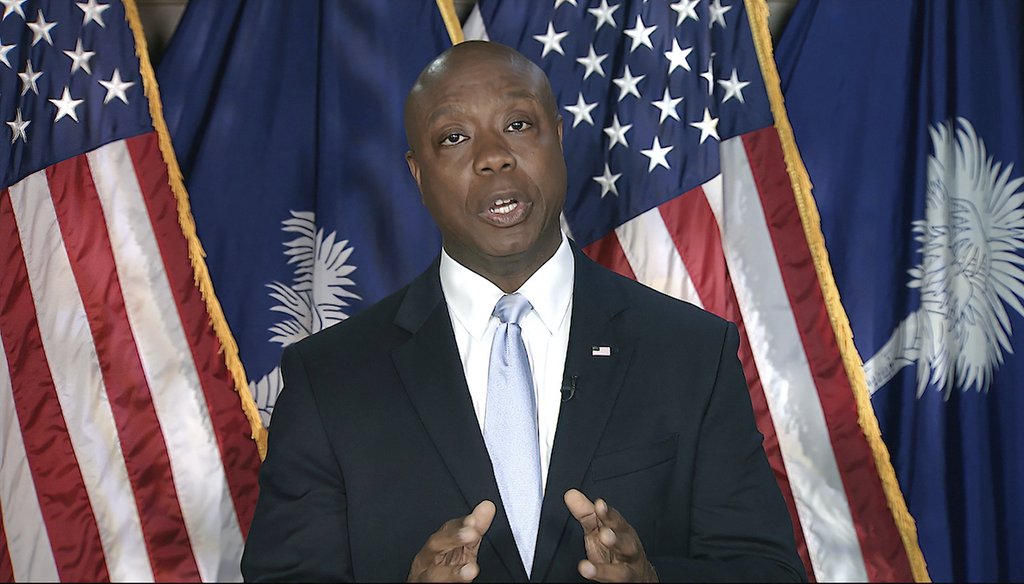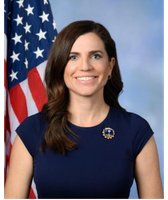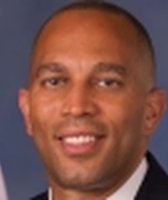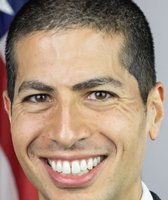Stand up for the facts!
Our only agenda is to publish the truth so you can be an informed participant in democracy.
We need your help.
I would like to contribute

Sen. Tim Scott, R-S.C., delivers the Republican response to President Joe Biden's speech to a joint session of Congress on Wednesday, April 28, 2021, in Washington. (Senate Television video via AP)
U.S Sen. Tim Scott, R-S.C., said President Joe Biden is dividing Americans and has failed to deliver on his promise of unity.
"I want to have an honest conversation," Scott said. "About common sense and common ground. About this feeling that our nation is sliding off its shared foundation and how we move forward together."
Scott, the Senate’s lone Black Republican, was chosen to deliver the GOP rebuttal to Biden’s speech to the joint session of Congress. Scott has been at the forefront of Republican efforts to offer a compromise to Democrats’ police reform legislation following the murder of George Floyd.
We fact-checked six of Scott’s claims, finding a mixed bag for accuracy.
"Republicans support everything you think of when you think of ‘infrastructure.’ Roads, bridges, ports, airports, waterways, high-speed broadband — we’re in for all of that! … Less than 6% of the president's plan goes to roads and bridges."
Roughly 6% of Biden’s proposal is devoted to roads, bridges and highways. But this leaves out other items that have long been considered "infrastructure" by politicians of both parties, and that Scott cited in his speech. When combined with the spending on roads and bridges, these elements total $683 billion, or about 26% of the $2.65 trillion proposal.
Join PolitiFact LIVE on May 10-13 for a festival of fact-checking with Dr. Anthony Fauci! Register today >>
The bill also includes funding for public transit ($85 billion), passenger and freight rail ($80 billion), airports ($25 billion), ports and waterways ($17 billion), protecting critical infrastructure and increasing resilience of land and water resources ($50 billion), high-speed Internet ($100 billion), power infrastructure ($100 billion), and drinking water supply system upgrades ($111 billion).
Republicans have criticized Biden’s plan for including items not historically thought of as infrastructure, including $400 billion for expanding access to long-term, home and community-based care under Medicaid.
Under President Donald Trump, "wages were growing faster for the bottom 25% than the top 25%."
Data from the Federal Reserve Bank of Atlanta backs this up, but it wasn’t unique to Trump. It was also true for most of President Barack Obama’s final two years in office, and the trend is holding under Biden.
However, the underlying metric — monthly wage growth — excludes non-wage income, such as investment income, that adds to the gains for those at the top of the economic ladder.
"Just before COVID, we had … the lowest unemployment ever recorded for African Americans, Hispanics, and Asian Americans. The lowest for women in nearly 70 years."
This is exaggerated, even beyond ignoring the recession caused by the pandemic.
On Trump’s watch, the unemployment rate did hit historic lows for Blacks, Hispanics, and Asian Americans, and it hit a roughly 70-year low for women.
However, the rate for each demographic started creeping up prior to the pandemic.
Black unemployment ticked up by 1.6 percentage points between its August 2019 low and March 2020, when the pandemic hit. Hispanic unemployment rose by 2 percentage points between its September 2019 low and March 2020.
Asian American unemployment increased by 1.9 percentage points between its June 2019 low and March 2020. And unemployment for women rose by 1.1 percentage points between its Sept. 2019 low and March 2020.
By the time Trump left office in January 2021, each of these groups saw their unemployment rate rise by multiple percentage points above their record lows: 4 percentage points higher for Blacks, 4.6 percentage points higher for Hispanics, 4.4 percentage points higher for Asians, and 3 percentage points higher for women.
"It will be easier to vote early in Georgia than in Democrat-run New York."
This is accurate as it pertains to the number of days of early voting. Georgia has offered early in-person voting for more than a decade and has more days for it than New York.
The new law in Georgia requires 17 days of early voting, but counties can offer up to 19 days, including optional Sundays. Georgia used to require 16 days. Counties must offer early voting from 9 a.m. to 5 p.m. but can extend that to 7 a.m. to 7 p.m.
In 2019, New York Gov. Andrew Cuomo signed a law to allow for nine days of early in-person voting, including four weekend days. The law says that polls shall be open for early voting for at least eight hours between 7 a.m. and 8 p.m. each week day during the early voting period. It also states that at least one polling place shall remain open until 8 p.m. on at least two week days. On the weekend, polls shall be open for at least five hours between 9 a.m. and 6 p.m.
Scott omits that there are some ways that New York’s voting laws are more generous than Georgia. For example, New York has longer Election Day voting hours.
"Our public schools should have reopened months ago. .... Private and religious schools did. Science has shown for months that schools are safe."
Scott’s statement about what the science has shown is generally accurate, but omits public health experts’ warning that schools should implement infection control precautions.
"Most private and religious schools have been open for the majority of the school year, and the vast majority have been extremely successful with minimal in-school transmission," said David Rosen, an assistant professor of pediatrics at Washington University in St. Louis. "But this is based on the premise that schools are performing the proper mitigations, especially universal masking and preventing symptomatic children from being in the classroom."
There have also been many examples of large public school districts that have had very few cases of COVID-19 transmitted in the classroom, Rosen said.
The American Academy of Pediatrics released guidance back in June 2020 that said, "All policy considerations for the coming school year should start with a goal of having students physically present in school" for the fall 2020 semester. The recommendations included requiring students to wear masks, maintaining a physical distance of 3 to 6 feet apart and potentially including testing and temperature checks in the safety protocol.
Schools have increasingly opened for in person instruction throughout the year, but some remain virtual. As of April 19, 4% of districts are fully remote while 47% of districts are fully in-person and about 48% of districts are offering some type of hybrid instruction, according to a tracker by the American Enterprise Institute.
Rosen said it was the right thing to do to shut down schools in March 2020 when we didn’t know much about the virus.
"We continued to learn over the summer of 2020, and by the fall it was pretty clear that the virus was not as morbid in children and that masking was key in preventing person-to-person spread," Rosen said.
"In 2015, after the shooting of Walter Scott, I wrote a bill to fund body cameras. Last year, after the deaths of Breonna Taylor and George Floyd, I built an even bigger police reform proposal. But my Democratic colleagues blocked it. I extended an olive branch. I offered them amendments. But Democrats used the filibuster to block the debate from even happening."
We rated this Mostly True.
Scott proposed a bill in June 2020, but Democrats blocked it from moving forward. Scott omits the reason that Senate Democrats blocked the measure: They preferred the House version of a police reform bill Democrats put forward the same month.
While both parties faced pressure to adopt police reform, partisan bickering and maneuvers led to nothing passing, and efforts stalled weeks later. Bipartisan negotiations are now underway with Scott leading on the Republican side, but it remains to be seen whether they will reach a compromise.
RELATED: Fact-checking President Joe Biden’s first speech to Congress
Our Sources
American Academy of Pediatrics, AAP interim guidance on school re-entry focuses on mitigating COVID-19 risks, June 26, 2020
Today Show, American Academy of Pediatrics president says schools should reopen, July 2, 2021
Washington Post, Opinion: The CDC’s latest demands will keep millions of kids out of school unnecessarily, Feb. 12, 2021
New York Times, We Asked 175 Pediatric Disease Experts if It Was Safe Enough to Open School, Feb. 11, 2021
New York Times, In Their Own Words: Why Health Experts Say Elementary Schools Should Open, March 2, 2021
American Enterprise Tracker, Return2learn Tracker, April 19, 2021
Email interview, David Rosen, an assistant professor of pediatrics at Washington University in St. Louis, April 28, 2021
PolitiFact, Ask PolitiFact: Are New York’s voter laws more restrictive than Georgia’s?, April 8, 2021
PolitiFact, What’s in Georgia’s new voting law that lost it the All-Star Game, April 7, 2021







































